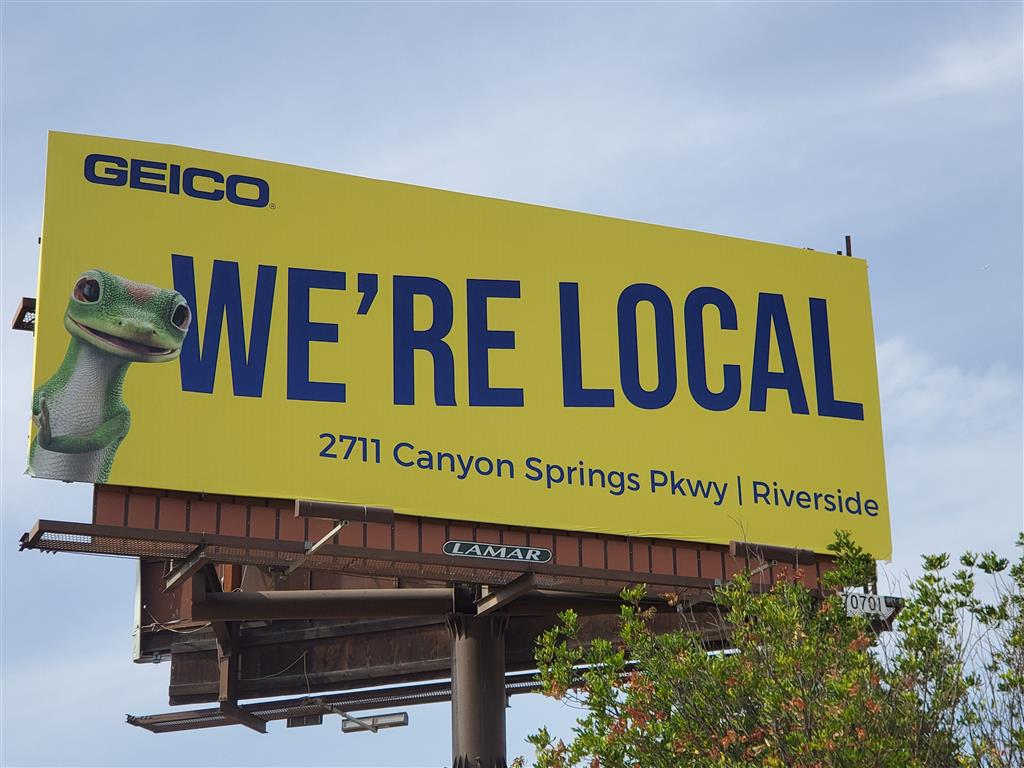
One of the takeaways from COVID-19 is just how important “local” truly is in our lives. The pandemic may have been global, but its shock waves were generally felt locally. For the past 14 or so months, the issues have been close to home.
Where can I buy toilet paper?
Does that restaurant offer curbside service?
When will our school system return to in-person teaching?
Are they requiring masks?
Where can I get tested?
Who is eligible for the vaccine?
Radio stations that embraced their “hometown-ness” stood the best chance of remaining relevant during COVID. But not every broadcaster was equipped with the human and financial resources to pull it off.
Local increasingly mattered to the core radio audience. A rising percentage of respondents in this year’s Techsurvey strongly agreed that “local” is a key advantage for broadcast radio. And that sentiment was felt pretty much echoed across the demographic board:
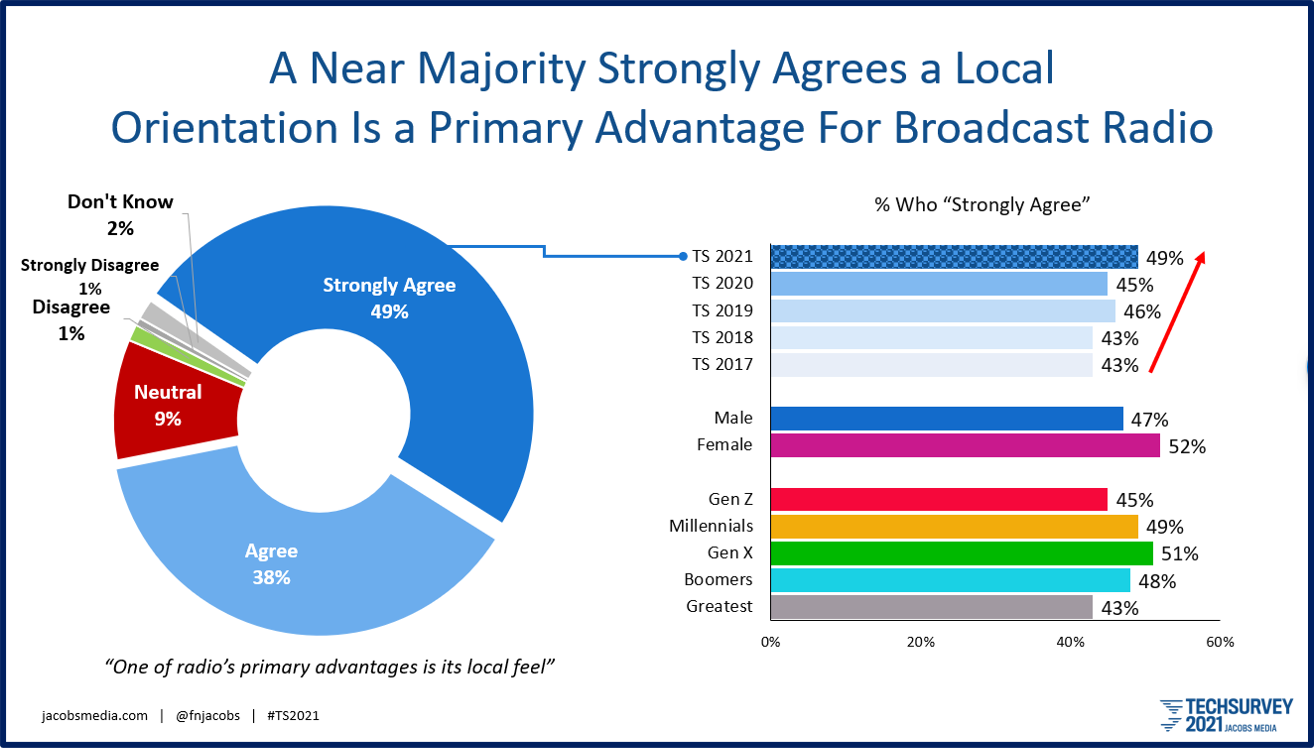
In 2020, all roads led back to local. And more and more, citizens are also coming to realize that political might often rests with local, county, and state representatives, empowered to make the decisions that affect us close to home. Elections and state, county, and municipal offices that were once ignored are taking on a much larger meaning.
It’s why even national brands like Geico go out of their way to remind us they have presence in our local communities. You would think they’d be content to fight their battles against other monster insurance brands like Progressive or Liberty Mutual. But Geico is also fighting the fight locally, right down to key zip codes. As you can gather from the billboard at the top of this post, Geico is playing to win in communities all over America. (Just search Google Images under “Geico we’re here billboards” and check them all out.)
Whether this a smart or feasible marketing claim for Geico to make is neither here nor there. What matters is that Geico’s team aspires to have local presence because “being from around here” has value in the hearts and minds of consumers.
It’s hard to fake local. New Era, the sports logoware maker, just launched – and then pulled – a line of caps “localized” for all 30 Major League Baseball teams. 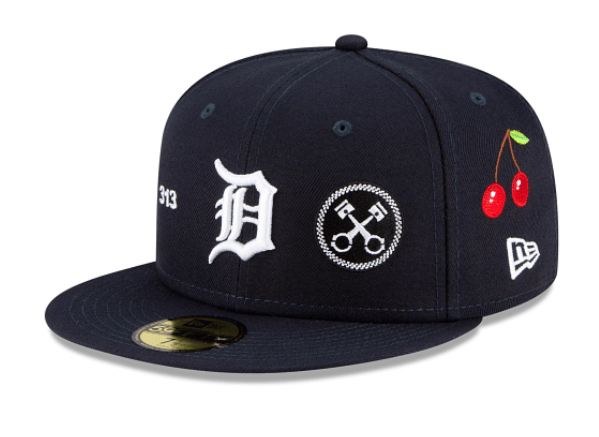 Apparently, they planned this project without bothering to check with any of the local teams, or even people who hailed from these cities.
Apparently, they planned this project without bothering to check with any of the local teams, or even people who hailed from these cities.
Each hat contains the area codes for each team’s market – except a number of hats either featured area codes no one recognized or omitted ones that should have been displayed.
The Cubs hat contained eight area codes. The Braves outdid them with nine. And inexplicably, the Pirates’ cap had none.
Then there were the geographic symbols for each team shown on the caps. Four out of the five California team hats displayed a taco. The Houston Astros hat featured a steak, while my Detroit Tigers chapeau showed cherries (which are indigenous to Traverse City!), what might be pistons, and only one area code.
I truly have no idea what this boat is pic.twitter.com/utYy5vTXQW
— Amy Plitt (@plitter) May 25, 2021
According to BroBible, the hats were ridiculed on social media, leading New Era to release this statement when the entire “Local Market” series was removed from e-commerce sites:
“…we removed the collection from our website so we could review the design accuracy of all the caps. We apologize for any unintentional design mistake with regard to this collection.”
But that’s how it works when you fake local. Ask any DJ or host that has started an on-air gig in a new market. Screw up the names of city streets or towns and it screams you’re an out of towner.
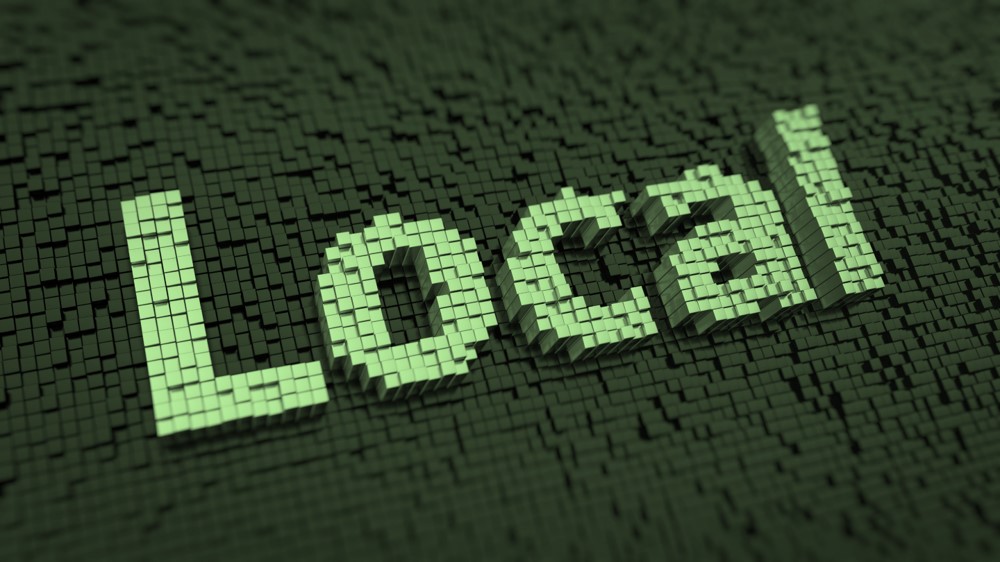 (Two of my favorite examples are the major Detroit streets, Livernois and Gratiot – pronounced Liver-NOY and Gra-SHIT respectively. You’d have to live in the Motor City to know that.)
(Two of my favorite examples are the major Detroit streets, Livernois and Gratiot – pronounced Liver-NOY and Gra-SHIT respectively. You’d have to live in the Motor City to know that.)
Consumers can almost always tell the difference when a jock isn’t authentic, often just from hearing a break or two. It frequently happens to me when I’m on the road – a barista or salesperson will ask, “You’re not from around here, are you?” They know.
There’s nothing wrong with being a national brand or a syndicated radio show when you own and embrace it. I was consulting WYSP in Philly when the decision was made to syndicate Howard Stern out of K-Rock in New York.
It would have been disingenuous, not to mention stupid, to hide or fake Stern’s whereabouts. And while conventional wisdom insisted a NYC personality could never make it in the City of Brotherly Love, Howard proved them all wrong.
Bob & Tom are proudly from Indianapolis, John Boy & Billy broadcast from Charlotte, while Dave & Chuck the Freak are out of Detroit. Fans demand a certain level of authenticity. And great radio shows can work no matter where they originate from.
But to do it locally requires hard work to embrace a market, its ethos and zeitgeist. It takes time to get to know the people, the landmarks, the urban legends, and the nooks and crannies that make a city special.
I admire radio pros who make it their mission to learn and understand what it means to be a Detroiter, a Duluthian, or a Denverite. I’ve watched Beasley’s Scott Jameson, a Clevelander by birth and a recent émigré from the Twin Cities, who now heads up programming for the Detroit cluster.
Detroiter, a Duluthian, or a Denverite. I’ve watched Beasley’s Scott Jameson, a Clevelander by birth and a recent émigré from the Twin Cities, who now heads up programming for the Detroit cluster.
In spite of joining the cluster early last summer when the pandemic was in full swing, Scott has focused on figuring out what it means to be a Detroit rocker – and bringing that to the airwaves on all the stations he oversees.
Week after week, he reminds his audience about how wonderful it is to be from the Motor City, highlighting Michigan artists while shining a light on all the great things about Detroit.
Talk to anyone associated with a great local brand, no matter the market, and they’ll tell you the power and incalculable value of exuding the hometown vibe. It’s not an easy thing. In fact, it is usually expensive to invest in talented local people, infrastructure, street tools, and the other assets necessary to have a great ground game and own the metro.
In fact, it’s so valuable that even some of the biggest global media brands are enamored with local. Like Spotify’s Gimlet division.
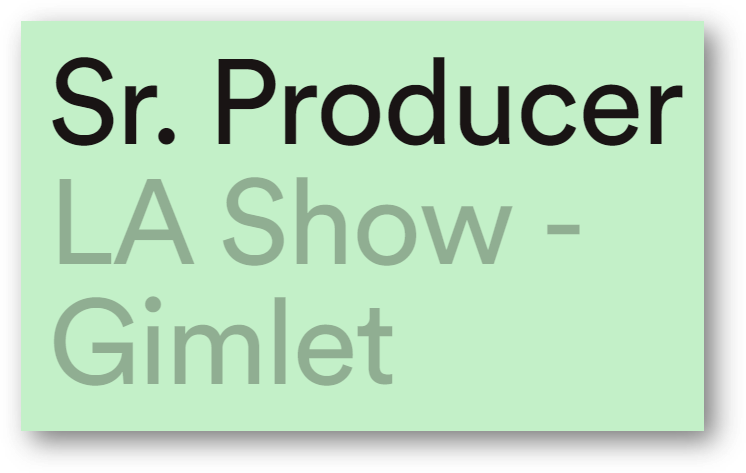 They’re now apparently building an afternoon drive “radio” show in Los Angeles. I recently ran across a heavily detailed want-ad seeking out a Senior Producer. Here’ the job description:
They’re now apparently building an afternoon drive “radio” show in Los Angeles. I recently ran across a heavily detailed want-ad seeking out a Senior Producer. Here’ the job description:
Spotify is launching a new daily show based in Los Angeles, publishing on weekday afternoons. This show will mix music and talk segments, in a modern take on afternoon drivetime radio. We are assembling a new production team to develop and launch a show that focuses on music, news of the day, and pop culture.
You can read the lengthy, highly-detailed job description here, as well as a pitch from Spotify about “the perks of being in the band.”
Yup, sounds like a radio show to me.
And while it’s not entirely clear whether Spotify/Gimlet is launching a radio show for LA or based in LA, it sure walks, talks, smells, and sounds like radio. But if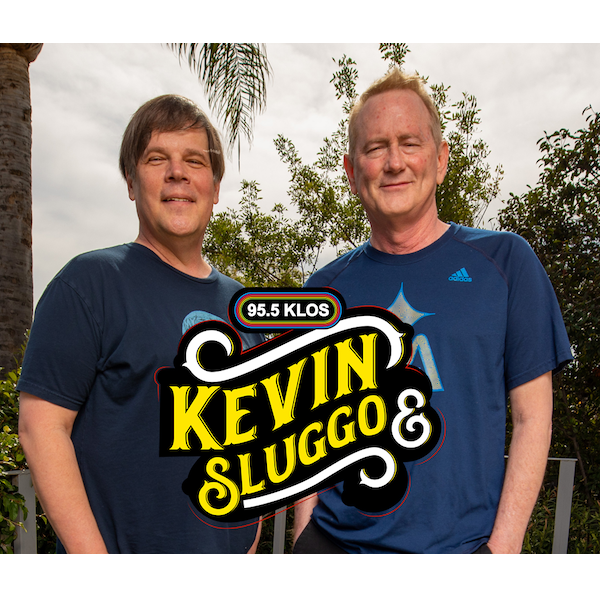 you’re driving home on the 405 or the 101, wouldn’t you rather be listening to a live and local radio show – like Kevin & Sluggo, a thoroughly hometown show on KLOS?
you’re driving home on the 405 or the 101, wouldn’t you rather be listening to a live and local radio show – like Kevin & Sluggo, a thoroughly hometown show on KLOS?
Spotify and Gimlet’s new “baby” is more proof positive that digital media brands perceive great value in broadcasting’s natural assets – specifically “radio” and “local.”
Ironically, Twitter’s heading down the “local” path, too. But their avenue is local weather. The company has created a new app called “Tomorrow.” In partnership with meteorologist and climate journalist, Eric Holthaus, Twitter is now jumping into the local content arena – yes, right in radio’s backyard.
According to Axios reporter Sara Fischer, “Tomorrow” will use all the Twitter new creator products – newsletter and live audio rooms. The new service launched in 16 North American metros featuring local meteorologists (the underline is mine).
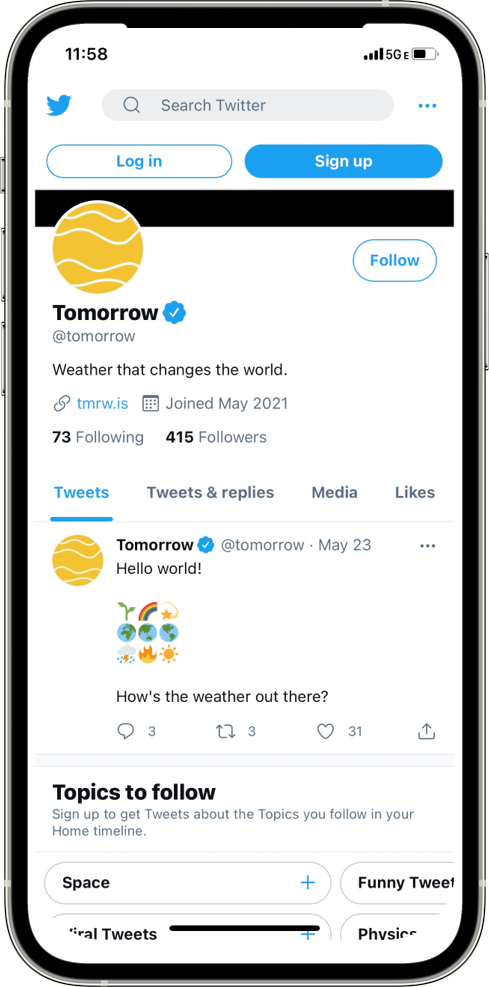 Here’s the interesting wrinkle – it’s a subscription service ($10/month). Holthaus believes they’ll be “revenue positive” not in the first year but in the first week.
Here’s the interesting wrinkle – it’s a subscription service ($10/month). Holthaus believes they’ll be “revenue positive” not in the first year but in the first week.
Other “Tomorrow” features include interactivity – users can share news and information, as well as ask questions of the weather experts.
Holthaus points out that a timely weather service totally complements Twitter’s “breaking news” model, and will be especially useful and popular during weather emergencies when users can send Direct Messages to meteorologists looking for timely and accurately information about emergency services, evacuation routes, etc.
The goal? “Tomorrow” could be in 50 major North American media markets by the end of 2021.
Of course, there’s an antidote:
If radio broadcasters do their jobs and live up to their potential and their capabilities, Apple, Amazon, Google, Spotify, Twitter, and SiriusXM can try to pull off “local radio” – but it will pale in comparison to the real thing.
That may come off as naive to the jaded who believe radio has already lost the war. But wouldn’t Los Angelinos rather listen to an afternoon drive show on a favorite radio station? And why would consumers in Cincinnati or Portland elect to pay Twitter $120 a year to get local weather reports?
But that assumes the radio product in these markets is top shelf, well-prepped, and expertly delivered by entertaining personalities who know the turf and have time in grade in their local markets. And these days, that’s a big assumption.
If those services and those personalities were cut loose, deep-sixed, or slashed from the budget during the last round of downsizing, furloughs, and reductions in force, well, it could be a challenge.
One thing’s for sure:
They’re after your domain. Don’t let ’em have it.
Thanks to Steve Goldstein.
- What To Do If Your Radio Station Goes Through A Midlife Crisis - April 25, 2025
- A 2020 Lesson?It Could All Be Gone In A Flash - April 24, 2025
- How AI Can Give Radio Personalities More…PERSONALITY - April 23, 2025




There’s a lot to unpack here – sorry for the cliché. I have a series of questions:
1) Hasn’t the live and local bar been, for the most part, raised above the top 20…leaving your Portland and Cincinnati examples to another era?
2) Would people under 40 really rather listen a great personality on radio than Spotify? Do they still listen to radio because it gives them a lot of what they want, or because its free and easy?
3) Here’s the big question…one that I’ll bet many would love answered. What do the decision makers in radio say about this subject? Your research – and I assume that of others, consistently shows that the live and local aspect is a key, maybe the biggest key that connects people to radio, yet they have responded as if it was the opposite. Based on their strategy, you’d think that the research said that listeners don’t know or care about local personalities and connection. I don’t expect (or even want) you to out anyone, but with some anonymization, what do the people at the top say when you point this very consistent research out? Do they think its wrong? Do they think they can head for the hub and spoke model and fake it so well that no one will notice? Is an anti vaxer analogy all that wrong – where there is an abundance of research and evidence yet the response is a steadfast refusal to believe it? Seriously, what’s their reasoning?
Bob, I’m not sure I know the answer to your first two questions. I suppose whether a true local personality could possibly resonate with Millennials and Gen Z’s is debatable. It might depend on who that DJ, host, or show is.
Your third question deserves a better response that I can give. I believe that most broadcast CEOs would, in fact, confirm the importance of “local.” (Bob Pittman’s comments in the Joel Denver interview here: Pittman Denver interview
But the distinction is that while it is easy to say you believe in local, pulling it off is a very different thing. Here’s the crazy part – a look at the top-rated stations in most big and smaller markets often (but not always) reveals intensely local brands, usually with iconic local personalities.
So, why isn’t there more of this kind of radio if it works? It is expensive, has a high degree of difficulty, and takes time. Many of the stations I referred to were built by different companies than own these stations today. Starting a truly local radio station that actually delivers in 2021 is a tough putt.
Some more questions:
1) What should we believe…what Bob Pittman says or what he does? An off handed comment about the importance of local in the face of the biggest “delocalization” in the history of radio rings sort of hollow.
2) What about starting “a truly local radio station that actually delivers” is a tougher putt than it was 10, 20, or 30 years ago? With so few remaining jobs for radio personalities, you’d think that the talent pool would be huge and the wage pressure low.
3) If the top rated radio stations in most markets big and small feature intensely local brands and iconic local personalities, yet no one wants to build one, does that mean that being top rated is no longer a goal or even a strategy for radio operators? If not, what are the current goals and strategies for radio stations and radio companies?
4) Where do they see themselves in 5 years? Apologies to the 80s that called and wants their job interview question back.
Good, probing questions all, Bob. They’d make a great panel at the All Access Audio Summit, so I hope Joel Denver is reading this. Of course, these are complicated questions that don’t have easy answers. Except perhaps for #4. Yes, it’s an oldie, but it forces people beyond the next quarter to plan for what’s down the road. I know the running joke that everyone who answered that question in 2015 got more than they bargained for five years later.
But it’s a serious question. Where do today’s industry leaders envision what we now know as radio in 2026? Given decisions of the past decade or two, it’s a damn good question.
And the response: “Who cares? I’ll be retired and on the golf course in five years – it will be someone else’s problem” is bullshit and unacceptable.
You’re spot-on again, Fred–as usual. “Local” is the greatest value; everything a listener needs to know from “away” (as Mainers say) they can from a top-of-the-hour newscast, or a newsbreak if it’s that important. When I’m in my car, even though it has Sirius, I usually prefer one of my local stations. Besides being local, even its analog signal puts the Sirius audio to shame; and the HD signal is better still (as you know).
As to the plight of talent who have arrived from “away,” they’d better stay home if they can’t be candid and genuine in their acknowledgment of their own origins and their enthusiasm for their new situation. A dear friend from South Carolina had the best response to the question you cite after he was transferred to Texas. When they said “You’re not from around here, are you?” he always replied honestly: “No–but I got here as quick as I could.”
John, thanks for the note. You and I are on the same page about the value of local. I’ve seen it work too many times. But check out Bob Bellin’s comment. He questions its efficacy among younger people – and he may be right. Thanks for the comment and that great story.
As usual a terrific blog post. A well selected title “You Can’t Fake Local”. A subject near and dear to my heart as I just began my 44th year of doing mornings in this market.
I have read countless articles down through the years about what list of things you need to do “local” right. Unfortunately, there is no slam dunk template that guarantees instant success.
I was asked a great question earlier this year on a Zoom with a group of communications students at Eastern Illinois University. “What’s the #1 show prep tool you use?”
I gave them two answers. First, surround yourself with people smarter than you. While I do a solo show, I have people in and out of the studio throughout the morning.
Second, a thousand “touch points” a month. 950 little things and 50 key things a month in our coverage area. I still do what one consultant called “little town s–t”…….birthdays, births, retirements and a thousand other things. Any way to drop a name, a neighborhood, a street, a business, a school that makes content sense I’ll integrate it.
I never intended to do mornings 44 years ago. At the time, I couldn’t find anybody quickly and only intended to it for the short term.
Even in the short term I decided to jump in with both feet. I started building a “Live Read” client base thanks to inspiration from Loman & Barkley and Harry Harrison. Many of those early clients are still with me today. This was long before “Live Reads” were viewed by most programmers as a positive personality attribute. What are referred to internally as “Mitm Lives” have provided a nice easy renewal revenue stream for a couple of dozen sales people down through the years. It was the primary reason I was asked to stay on the air after I retired from programming my first 22 years in C-U followed by Assistant GM then GM over the last 21 years.
You can’t take my show into any other market, it would fail miserably. I have reinvented how I prepare and how I execute it over and over down through the years. One constant guiding principle, I try to be part of the fabric of our various communities each and every day.
When I first started in this market I had five primary competitors and Larry Lujack from outside of the market on WLS. By the late 90’s I had over a dozen radio stations to battle plus local TV getting into the morning show business. The onslaught of new competitors on every consumer platform the last dozen years is not for the faint of heart of for “veterans” like me.
But……..Nothing has really changed in 44 years. Despite the increased competition, it’s all about content and delivering on listener expectations.
I am blessed that our content appears to still be relevant.
Thank you again Fred for writing on this subject. I appreciate your daily blog.
Mike, you’ve written your own blog post here and I hope aspiring air talent take the time to read it. It speaks volumes about doing the little things, doing them well, and then doing them again. There’s also a lot to be said for your instincts. I get the feeling you went with your gut, and you were more right than wrong.
I love this line: “You can’t take my show into any other market, it would fail miserably.” It’s humble…and true. And that’s why your show is so successful in Champaign. Congratulations on a truly amazing “live & local” run.
You’ve got some pretty smart readers here, Fred. My biggest impression comes from Bob Bellin who asks “What should we believe…what Bob Pittman says or what he does? An off handed comment about the importance of local in the face of the biggest ‘delocalization’ in the history of radio rings sort of hollow.”
He’s been joined by at least one other major broadcast hotshot. Every time I see someone describing the pitfalls and solutions to broadcast radio’s ills, I ask the same question. Where are the big shots? Research is one thing, the actual application of that is another. Rob Halle says “it’s all about content and delivering on listener expectations.”
So- when WE seem to know what’s right, and the big shots are 180 degrees out of sync, who wins?
Like so many things these days, Dave, “local” is in the eye of the beholder. And there are many smart people in radio who believe it’s not that big a deal anymore. True that.
This comment might work better without the word “smart”.
This is another excellent post Fred.
One of the things that I’ve been watching is the nibbling away of the local franchise that radio has in many markets.
Using your hometown as an example, I became aware just this week of a daily podcast and newsletter called Daily Detroit (https://www.dailydetroit.com/) that fills a gap in serving podcast listeners in the city with local information in a way that radio has traditionally done. It may not be the greatest production in the world, but it’s there taking the space that should be radio’s sweet spot.
The folks involved in this seem to be very local (which is good) – but it seems like this is where radio needs to go, and we’re not moving fast enough to get there. And this kind of thing is happening in a lot of markets across the country by non-radio players.
Hey Tim! I’m part of Daily Detroit. Neat you discovered us and thank you for mentioning. I read the occasional post here.
A few things to note about our project to build on your comment. NPR’s median listener age is 54 last I looked; ours off the top of my head is around 30. Anecdotally, our listeners have mostly cut out the radio tower out of their day (they for sure do radio shows served as podcasts). Either way they’ve lost the radio habit or never had it in the first place, and those who have lost it? It’s because their local voices have been silenced and the stations generally haven’t adapted.
And when it comes to music, if a computer with no local guide or personality is going to serve the content anyway, then radio will always lose because Spotify and Apple have the data to do it better in the eyes of the consumer. Often radio does the worst of both worlds. It leverages neither algorithm or art.
Our audience’s sensibilities, tone, and story preferences are different than what someone serving the 55+ crowd would be, too. I ensure our contributors have the freedom to experiment. That’s how, for instance, we can pick up an audience covering our local pro soccer club each week during the season when mainstream radio won’t because apparently it’s not great for call-in talk radio format. But it works for us.
Those fans then often stay for everything else.
Our audience is smart, passionate, and wants to make where they live a better place. They’re more interested in policy than politics. We have more experts on than pundits.
Although we may not be the greatest production in the world as you say, we aim for consistently decent with what we have and I’d like to think have improved over nearly 800 episodes. And there is still, of course, more work to do.
The underlying sea change is cultural and nothing is a given in an on-demand world. So we work to earn every listener, every day and it’s a constant path of improvement and learning. We do it out of love for our places we live.
To quote the Lorax, “Unless someone like you cares a whole awful lot, nothing is going to get better. It’s not.”
Great article. I gave up on Local radio when I listened to a drive home segment (probably 5:45) where four comedians in Cleveland talked about what conditioner they use in their hair (product placement? probably), or when I turn on the radio at night to hear the same pre-programmed songs only to be interrupted with what sounds like Siri as the DJ announce that it was Eddy Money, Two Tickets to Paradise. Boring
If radio wants local people to tune in, they need to put back what they sucked out of the radio – the personality (which is the underlying theme of this article, each city has its own personality, and hence every station should sound different – but they don’t. It’s all the same stuff).
I have Alexa remind me to turn on the radio on Saturday nights as WNCX has five hours of all request radio, and get this, they actually play stuff that people request. The host (Kenny the Kid) has a HUGE amount of knowledge when it comes to rock, and it’s like no radio I’ve heard in over 30 years. A show with a personality. A personality I want more of.
In the documentary corporate.fm (on Amazon) they show how there was a catastrophe and as all the stations were on autopilot, and they had one news person for five stations, they never broke into the programming to let people know to evacuate the city.
You said, “it’s all about content and delivering on listener expectations.” When I got into podcasting in 2005 you could get by with audio that sounded horrible. Not anymore. Radio is king because you couldn’t fit a record player in your car when I was growing up. I think Spotify’s local LA attempt is interesting. After all, I have the temp and weather on my Apple watch, the traffic report in my WAZE app, it will be interesting to see how niche they go with their content. Listener expectations may be higher. The personality-based content of (good)podcasts may need to be mixed into radio to compete.
Dave, thanks for this. I know I can be accused of being “a homer” (at times), but I still hear moments of “localness” on the radio that still resonate. I just wish I heard them more often and across more stations.